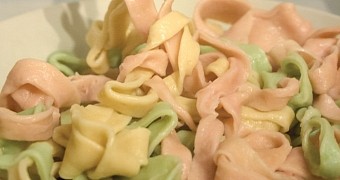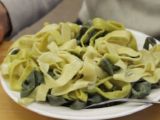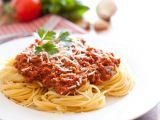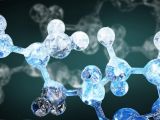It so happens that, contrary to what many assume, there's more to being a scientist than sitting in a lab and moving Petri dishes and microscopes around day in, day out.
As proven by two brainiacs with the University of Warwick in the UK, science experiments can also be carried out in the kitchen.
Not to beat about the bush, it was not too long ago that these researchers used a couple of eggs and some flour to make pasta not because they were terribly hungry and in the mood for a hefty dose of carbohydrates, but to illustrate the behavior of ring polymers.
First things first, here's what ring polymers are
As explained by scientists, polymers are basically large molecules, otherwise known as macromolecules, that comprise plenty of repeated subunits dubbed monomers. Polymers are both naturally occurring and synthetic.
Just to put things into perspective, it must be said that DNA, which encodes the genetic instructions each and every organism needs to grow and function, is a natural polymer. Polystyrene, on the other hand, is a synthetic one.
Whereas some polymers occur in the form a chain, others take the shape of a loop. Such ring-shaped polymers are mind-bogglingly complex, University of Warwick scientists Davide Michieletto and Matthew S. Turner say.
Hence, they aren't very well understood, Phys Org explains. As the two brainiacs put it, “The thing about ring-shaped polymers is that they're very poorly understood – in fact, they're one of the last big mysteries in polymer physics.”
Using pasta to make a case about ring polymers
In a report documenting their work, the University of Warwick specialists explain that, to make a case about ring polymers, they used eggs and flour to create loops of pasta. When cooked, these loops got tangled up, making it downright impossible to pull just one of them out.
The scientists behind this odd experiment explain that, just like the pasta they created, which they call anelloni, ring-shaped polymers have a tendency to intertwine with each other. Apparently, they can even get so tangled up that they pretty much freeze in place.
How this study isn't about oddly-shaped pasta
Davide Michieletto and Matthew S. Turner explain that, if ring-shaped polymers too become frozen in place when the loops are too long, as was the case with their pasta, this could translate into the discovery of a new state of matter that the researchers call topological glass.
The brainiacs say that, whereas regular glassy material is obtained by cooling a viscous liquid up to the point where the molecules that comprise it stop moving, topological glass made by putting together ring-shaped polymers would freeze in place depending not just on temperature, but also on the length of the loops.
“What would be nice about a topological glass is that its properties would be governed purely by topology, rather than the system-specific chemical details that often control when and how classical glasses form,” the University of Warwick scientists say.
It is believed that, were ring-shaped polymers to really hold the key to a new state of matter, this could translate into the development of a new generation of materials.
Check out the video below to learn more about ring-shaped polymers and have a better look at the pasta the University of Warwick researchers created to demonstrate the properties of such macromolecules.

 14 DAY TRIAL //
14 DAY TRIAL // 



